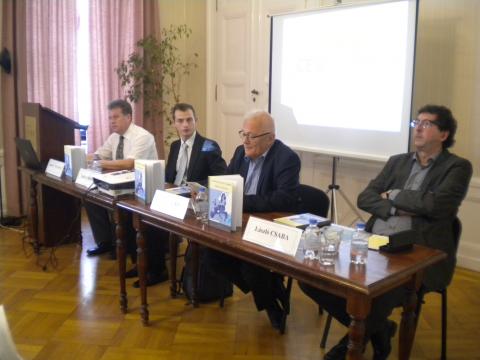Budapest book launch report: “A European Union with 36 Members? Perspectives and Risks”

On 13 October 2014 the Center for EU Enlargement Studies (CENS) launched in Budapest its book entitled “A European Union with 36 Members? Perspectives and Risks”. The book presentation held at the premises of the Central European University (CEU) was an opportunity to present the final outcome of the multi-annual project called “EU36” whose main goal was to support the issue of enlargement and to discuss the future political, economic, socio-cultural and security aspects of a greater EU.
The editor and author of the book, Péter Balázs, said that a European Union with 36 members is a pure working hypothesis today. Extending future territorial contours is in full harmony with one of the main political objectives of the organization as the European Communities offered the possibility of membership to “all European states” from the first day of their existence. A starting point for analyzing the potential next size of the expanding EU was the Enlargement Report issued by the European Commission, which inspired this research and the series of international conferences held in 2012 and 2013 trying to analyze the various aspects of the hypothetical EU36 model. The project was initiated by CENS three years ago and carried out together with an international network of core partners.
One of the authors, Andrew F. Fieldsend, presented his article entitled “Putting ‘Rural’ at the centre of the European Union’s cohesion and enlargement policy” in which he explores the place of rural areas in EU policy for the programming period 2014-2020 in two respects. Firstly, with regard to the targeting of available funds to existing (i.e. as of 2012)EU27 member states, and secondly with regard to lessons we can learn from this analysis that may be of value to EU candidate and potential candidate countries. The paper notes that in the 2007-2013 programming period EU Structural Funds were a much larger source of funding for rural development, broadly characterized as a process to enhance the quality of life of rural residents and the economic performance of rural areas, than was the Common Agricultural Policy (CAP), but that rural areas may have been receiving an inadequate share of this funding. Fieldsend also noted that there has been a disappointing lack of evidence of quantifiable ‘spread effects’ to support a ‘growth pole’ approach to regional development, in which investment in urban centers generates economic benefits for their rural hinterlands. He concluded by saying that employment in rural areas is diverse, not just agriculture; rural areas have a greater need for SF investments to promote economic prosperity; structural funds, national and private sector funds, not just CAP funding, must support rural economic development; delivery of structural, CAP (and national) funds should be better aligned.
The other author, Endre Orbán, outlined the main messages of his paper “EU budget and common policies. Regional policy: What’s next?” The purpose of his paper was to assess quantitatively the impact of the further enlargement of the EU on its budget and particularly on the structural funds of the EU. He showed that only Turkey would involve a greater impact in terms of the regional policy, which would also contribute largely to the EU budget with its yearly growing economy. The Western Balkans countries taken individually have only a slight impact on the average GDP of the EU. Orbán also demonstrated that the share in the structural funds of the new potential member states might be between 25.7% and 27.31% which could be assessed as extremely high, but this is nothing new. In 1987, Portugal, Spain, Ireland and Greece were eligible for 35% of the structural funds, while their contribution to the central budget was only 7.7% and their population was only 19% of that of the Community.
The book was presented by László Csaba, Professor of international political economy at CEU, who began by saying that universities are about generating new knowledge and that the new ideas presented in the book are serving precisely that purpose. The book is a result of the collaborative research which brings together junior and senior authors, new and old member states, west and east and they mutually bring new insights that emerge in the book. As the book covers five different thematic areas, Csaba tried to summarize the main messages of each chapter. “Extending the single market from 27 to 36” and the notion of ‘ever-growing Europe’ is a very broad idea. He noted that after Juncker’s message about no prospects of further enlargement in the next five years and with events in Ukraine and Syria, we experience that things are deteriorating and we have to take care of ourselves. The second and third chapter “Budget and common policies” and “Eurozone” are dealing with big and complex issues (labor market, cohesion). The Eurozone turned out to be a deeply political project and a financial project at the same time. Most CEE countries have not become part of the Eurozone and the book poses the question if that is a rational and good choice or not? Csaba emphasized that the book is particularly strong on regional dimension which is dealt with in the fourth chapter “New foreign policy dimensions and regional cooperation” talking about divergence in Turkey and convergence in the Western Balkans. The fifth institutional chapter “Institutions, democracy, and identity with 36 member states” is in his view the most controversial one, especially the article written by the editor of the book in which he suggests numerous institutional reforms without which the whole structure of the EU could become questionable. Professor Csaba concluded by emphasizing that the book is unconventional with many critical points, analyzing many different topics that can attract a wide reading public.
For more information about the book, project, main messages, and the list of contributors and participating institutions, please see the document attached.
The book can be purchased at CENS (35 USD/29.95 EUR/24.99 GBP) or will be available at Amazon.com at a later date.
